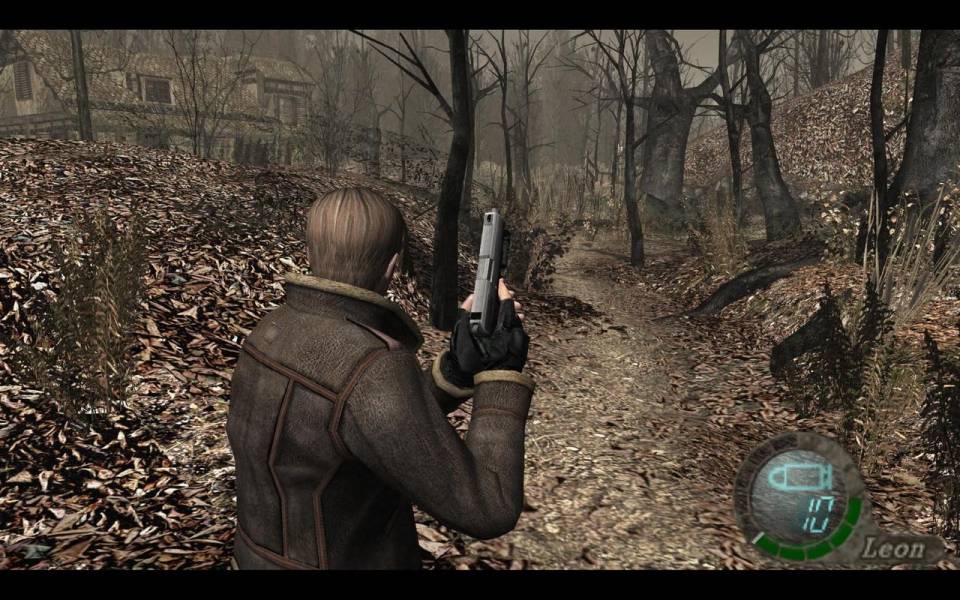Resident Evil 4's Silent Tutorial
By Daneian 4 Comments

Fifteen minutes into Resident Evil 4, Shinji Mikami and his design team test your comprehension of the mechanics they’ve been invisibly teaching you since you selected ‘New Game’. Former rookie cop Leon S. Kennedy had just fought his way through the Ganado’s Village and now finds himself catching his breath on an old dingy farm. Stray slightly from the beaten path and you’ll find a radiant pearl necklace enticingly suspended above a barrel of putrid water, patiently waiting for you to find it. Retrieving this necklace is your test. You can’t just reach out and interact with it, so you draw your handgun and shoot it loose- and immediately fail as it falls directly into the barrel of sludge beneath. When you pull it from the filth, your inventory lists the item as ‘Dirty Pearl Pendant’, its picture a grimy mess. Looking back at the barrel, you notice the 2x4 propping up the lid, so you shoot that next and watch it create a cover. Since you didn't learn the lesson before, you do now: Resident Evil 4 rewards tactical gunplay.
Let’s study the notes:
Despite their radical attempts to experiment with new narrative techniques, the first mainline Resident Evil titles are largely remembered for controls and mechanics designed to facilitate a very specific gameplay. While each successive game made iterations to the core mechanics, what is true of Resident Evil’s core is true of Code Veronica’s. That changed with 4.
You can discover the games core design pillar, the one every gameplay mechanic is based on, without having your hand on the controller- the game’s camera is placed just behind and above Leon’s right shoulder. Leon’s figure defines the middle left quarter of the screen from the waist up, his head pointed directly towards a small wooden house fifty feet away and immediately establishes your current objective. Because you recognize you can’t move forward, you turn to the right where the hill tapers into a path. You now know that left and right control Leon’s horizontal orientation and up and down move him forward or back in the direction he’s facing. You test out the other buttons. You can run, pull out a knife and draw your handgun.
Pulling the right trigger, the camera zooms closer in and you see a red laser sight extending from the handguns muzzle. When you move it around and see how it tracks you realize that the sight moves relative to Leon’s perspective rather than your own but the two coalesce with a bounding box: while the camera moves one to one with vertical axis input, horizontal movement has some play and keeps the camera static when pointed in the middle half of the screen. The end result has you controlling Leon as if he was playing a light gun shooter (fine Metroid Prime 3). Then you see the laser sight come to a point on the black shape of a crow sitting on a branch. That means you can shoot it. And you do. There’s two more on the dirt. Three separately placed targets to practice on. You’ve learned to shoot.
When he gets to the small shack, Leon finds a Spanish man stoking the fireplace. When Leon tries talking to him, the man grabs an axe and swings. You regain control as he comes slowly at us, hand raised. You scramble for the trigger draw our gun again, put a round in his chest, in his arm, and see that while he is still coming towards you, the bullets are having different effects based on the location they hit. When a bullet takes out his feet he staggers into you and a ‘Kick’ prompt allows Leon to deliver a strong roundhouse that sends the man flying. With him on the ground, a headshot will end the fight. The man’s behavior is unlike any of the other monsters Leon has fought and we discover why when he investigates the body- ‘He’s not a zombie…’
You turn back to the door and find it barred from the outside. You'll have to find another exit. Since the house is so small, you run up the stairs, past a window and to a small desk with a box of ten handgun bullets. On your way back down, you pass the window again and get a prompt letting you know you can jump out. If you do so, you’ll find yourself exposed to three enemies creeping straight towards you. If you take a moment to look out the window, you’ll see one of those enemies centered perfectly within the windows frame. Breaking the glass with your knife, you can calmly aim at the man’s head. From your perch, you can shoot two of the three guys and then jump out the window and take the last. The lesson becomes more advanced: maps can be designed with verticality and wise placement comes with advantage.
The long path forward consists of a few curves that get you well acclimated to the movement. A hundred feet in you come to a wolf trapped in a bear trap and while you’re given the opportunity to free it, the larger point is to make you aware of environmental hazards. You’ll run through an obstacle course of traps and tripwire. The game wants you to get good at squeezing through tight spots.
The second map is the village, a complex space with cover, alternate paths and verticality. From the path you entered, you could rush straight into the thicket of enemies in guns blazing but by taking the route to left, you bypass them behind the safety of the houses. At the far end, you’ll find the first female villager busy bailing hay. You might drop your guard, thinking her tamer than the others. You’ll only think that until she turns her pitchfork on you. Aside from the gameplay of the geometry, the layout of the village is logical as a living space with houses, stables and a tower. It’s a living place that feels organic to the setting and not built directly for the gameplay.
Fighting the woman off gave the rest time to circle around you. As they close in, you’re forced to apply more advanced combat techniques than you were aware you possessed. It starts defensively as the location based damage system allows you to tactically trip up enemies buying yourself both room and time to reposition. Your understanding of the environment grows as well as you run into a house, barricade the door, knock down a ladder from a second story window and jump off the roof in an attempt to juggle enemies and plan your fight against the mob bearing down on you. So far, analysis has portrayed the gunplay as the sum of two distinct gameplay concepts- crowd control and complex level design both with offensive and defensive options. In this scene we discover a third that informs a fundamental design choice that we had tackled earlier.
When we shoot a flying axe out of the air, we notice that Leon’s gunplay allows trick shooting. Let’s take a second to look back at Leon’s laser sight which is a very specific aiming mechanic for a game to implement on purpose. In his excellent God Hand review, Hamish Todd observes that every enemy in that game exists on a separate plane consisting of it and you. Considering how God Hand’s movement and camera designs were taken from Resident Evil 4, maybe that conclusion applies here as well. Maybe that’s why Leon could shoot that axe out of the air- it exists on a line connected to him and his gun. Compare that to the reticle used in other third person games, where guns fire in relation to the orientation of the controller’s right thumbstick. Not only would trick shots be more difficult (since you’re essentially trying to hit a target perpendicular to its trajectory) but would make enemies less physically threatening because of the nature of three dimensional controls: you could have simply sidestepped the axe. At that point, why even have it?
It’s a waste of time to try to figure out which came first, the bounding box or the trick shot gunplay, because the two are so intrinsically symbiotic that you can’t analyze one divorced from the other. In fact, that’s the beauty of Resident Evil 4’s design- the gameplay succeeds because the gunplay, crowd control and traversal options all fit together into a unified whole, on that would have failed if any part wasn't properly constructed. Regardless of the wisdom of so strictly adhering to the staid movement controls of the franchise, the cohesive combat form as it exists in incredibly tight.
The fight tears through your ammo. As you frantically scour the area for weapons, ammo and health, you find that the series traditional concept of exploration has evolved into something new, something more active, more aggressive. Depending on how well you explored the first map and fought the eight enemies along it, you could be coming into this fight with sixty handgun bullets, two grenades and several herbs. If you rushed through the area needlessly wasting ammunition you’ll likely find yourself in a frenzied scramble for supplies. This desperation transforms the games exploration into a tense struggle to survive.
Tense is a very accurate description. In studying the individual gameplay systems, we’ve also found the games central emotional tone. Where the series had lived in B-movie horror camp, it’s now big budget action horror; the dangers are no longer around the next corner but behind your back and just out of your line of sight, stalking you with their axes raised. The way the camera is placed so closely to Leon’s back creates a palpable claustrophobia that pulls at your hindbrain. No place is safe- enemies climb through windows and destroy barricades and force you to be constantly on the move. You know that part in suspense movies where the hero’s fate depends on their ability to light a match? These fight scenes are the constant ball of tension and ecstasy of relief of those moments as you raid the village of its spoils, constantly hunted. Then you hear a chainsaw fire up, its throttle rattling. It’s a fast and frenetic fight.
Then it ends, your enemies drawn away by the ringing of the chapel’s bell. Leon stands in in the center of the now abandoned village, bewildered by the sudden turn f events. A late title card pops and we learn our final lesson: this is Resident Evil 4. It’s a game built of familiar concepts but applied into a whole that is both an evolution of the one’s that preceded and a bold new direction for its future. Your test awaits.
